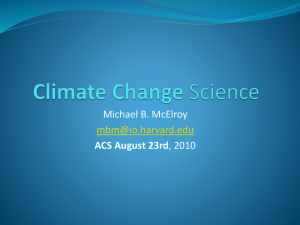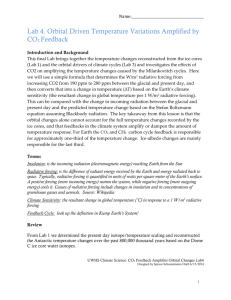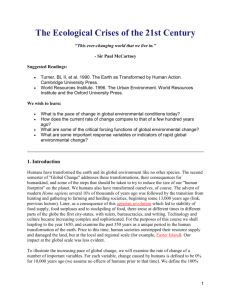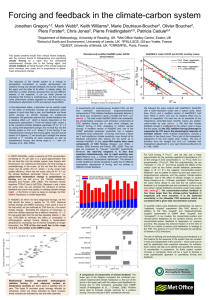\section{Temperature and precipitation changes using idealized
advertisement
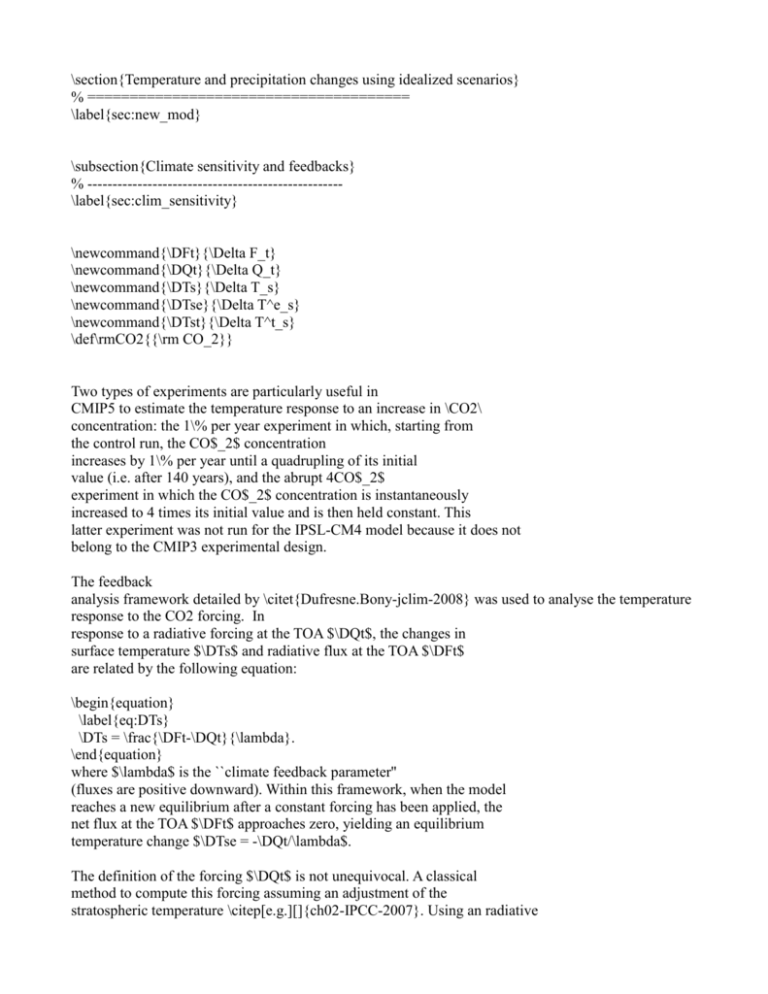
\section{Temperature and precipitation changes using idealized scenarios}
% ======================================
\label{sec:new_mod}
\subsection{Climate sensitivity and feedbacks}
% --------------------------------------------------\label{sec:clim_sensitivity}
\newcommand{\DFt}{\Delta F_t}
\newcommand{\DQt}{\Delta Q_t}
\newcommand{\DTs}{\Delta T_s}
\newcommand{\DTse}{\Delta T^e_s}
\newcommand{\DTst}{\Delta T^t_s}
\def\rmCO2{{\rm CO_2}}
Two types of experiments are particularly useful in
CMIP5 to estimate the temperature response to an increase in \CO2\
concentration: the 1\% per year experiment in which, starting from
the control run, the CO$_2$ concentration
increases by 1\% per year until a quadrupling of its initial
value (i.e. after 140 years), and the abrupt 4CO$_2$
experiment in which the CO$_2$ concentration is instantaneously
increased to 4 times its initial value and is then held constant. This
latter experiment was not run for the IPSL-CM4 model because it does not
belong to the CMIP3 experimental design.
The feedback
analysis framework detailed by \citet{Dufresne.Bony-jclim-2008} was used to analyse the temperature
response to the CO2 forcing. In
response to a radiative forcing at the TOA $\DQt$, the changes in
surface temperature $\DTs$ and radiative flux at the TOA $\DFt$
are related by the following equation:
\begin{equation}
\label{eq:DTs}
\DTs = \frac{\DFt-\DQt}{\lambda}.
\end{equation}
where $\lambda$ is the ``climate feedback parameter''
(fluxes are positive downward). Within this framework, when the model
reaches a new equilibrium after a constant forcing has been applied, the
net flux at the TOA $\DFt$ approaches zero, yielding an equilibrium
temperature change $\DTse = -\DQt/\lambda$.
The definition of the forcing $\DQt$ is not unequivocal. A classical
method to compute this forcing assuming an adjustment of the
stratospheric temperature \citep[e.g.][]{ch02-IPCC-2007}. Using an radiative
offline calculation with stratospheric adjustment, we obtained
$\DQt(2\rmCO2) \approx 3.5 W.m^{-2}$ (3.7 \Wm2 in clear sky
conditions) for a doubling of the \CO2\ concentration, and twice these
values ($\DQt(4\rmCO2) \approx 7.0$ \Wm2, (7.4 \Wm2 clear sky)) for a
quadrupling of the \CO2\ concentration. The same values were obtained
for the IPSL-CM4, IPSL-CM5A and IPSL-CM5B models which have the same
radiative code. For intermediate values $x$ of the ratio between the
\CO2\ concentration and its preindustrial value, the radiative forcing
is estimated using the usual relationship:
$\DQt(x)=\DQt(2\rmCO2).\log(x)/\log(2)$. Using this forcing and the
results of the 1\%-per-year experiment, the time series of the climate
feedback parameter $\lambda$ were computed for the different versions
of the IPSL-CM model. The values reported in \tab{feedback} are the
30-year average values of $\lambda$ around the time of \CO2\ doubling
(i.e. between years 56 and 85). The feedback parameter $\lambda$ in
IPSL-CM5A-LR is very close to that in the previous version, IPSL-CM4,
and it is also very close to that in IPSL-CM5A-MR. On the other hand,
the value of the feedback parameter in IPSL-CM5B-LR differs by about
70\% from that in the other model versions. The same results hold for
the equilibrium temperature change $\DTse(2\rmCO2)$ for a doubling of
the \CO2\ concentration (often called ``climate sensitivity'').
\begin{table}[ht]
\begin{center}
\begin{tabular}{|l||c|c|c|c||c|c|c|}
\hline
~ & \multicolumn{4}{|c||}{~}& \multicolumn{3}{|c|}{~}\\
~ & \multicolumn{4}{|c||}{1\%/year \CO2\ increase}& \multicolumn{3}{|c|}{abrupt 4x\CO2}\\
~ & \multicolumn{4}{|c||}{~}& \multicolumn{3}{|c|}{~}\\
\multicolumn{1}{|c||}{model} & $\DQt(2\rmCO2)$ & $\lambda$ & TCR$(2\rmCO2)$ &
$\DTse(2\rmCO2)$ & $\DQt(2\rmCO2)$ & $\lambda$ & $\DTse(2\rmCO2)$ \\
~ & ~ & ~ & ~ & ~ & ~ & ~ & ~ \\
~ & (\Wm2) & (\WmcK) & (K) & (K) & (\Wm2) & (\WmcK) & (K) \\
\hline
IPSL-CM4
& 3.5 & -0.92 & 2.13 & 3.79 & ~ & ~ & ~ \\
IPSL-CM5A-LR & 3.5 & -0.98 & 2.09 & 3.59 & 3.12 & -0.76 & 4.10 \\
IPSL-CM5A-MR & 3.5 & -1.01 & 2.05 & 3.47 & 3.29 & -0.80 & 4.12 \\
IPSL-CM5B-LR & 3.5 & -1.68 & 1.52 & 2.09 & 2.66 & -1.03 & 2.59 \\
\hline
\end{tabular}
\caption{\label{tab:feedback} Radiative forcing for a doubling of \CO2
$\DQt(2\rmCO2)$, feedback parameter $\lambda$, transient
TCR(\CO2) and equilibrium $\DTse(2\rmCO2)$ surface air
temperature increase in response to a \CO2\ doubling for the different
versions of the IPSL-CM model. These values (except the transient
temperature response) are estimated using either the 1\%/year \CO2\
increase experiment or the abrupt 4CO$_2$ experiment.}
\end{center}
\end{table}
Another classical metric to characterize the response to an increase
in \CO2\ concentration is the ``transient climate response'' (TCR),
i.e. the surface air temperature increase in a 1\%-per-year experiment
when the \CO2\ concentration has doubled, i.e. 70 years after it
started to increase (here we computed the 30-year average, i.e. the
average between years 56 and 85). This transient temperature change is
found to be very close for IPSL-CM5A-LR and IPSL-CM5A-MR
(\tab{feedback}). This result is consistent with those obtained by
\citet{Hourdin.ea-cdyn-2012a} with a broader range of horizontal
resolutions of the atmospheric model. This transient temperature
change is also close for IPSL-CM4 and IPSL-CM5A-LR. Again,
IPSL-CM5B-LR is different from the other models, with a much lower
value ($\approx -25\%$) of the TCR.
\begin{figure*}[ht]
\centering
\includegraphics[width=\linewidth,angle=0,bbllx=0,bblly=345,bburx=502,bbury=502,clip=]{\dfig
fit_Q_L_IPSL.eps}
\caption{\label{fig:fit_Q_L_IPSL} Scatter plot of the net flux change
($\DFt$ in \Wm2) at the TOA as a function of the global mean surface
air temperature change ($\DTs$ in K) simulated in response to an
abrupt quadrupling of \CO2\ concentration. The net flux at the TOA
is computed for (a) all sky conditions and (b) clear sky
conditions. The difference between these two terms is the change in
the cloud radiative effect (c). Annual mean values are shown in black
for IPSL-CM5A-LR, in blue for IPSL-CM5A-MR, and in red for
IPSL-CM5B-LR. The straight lines corresponds to linear regressions of
the data. Intersection with the horizontal axis ($\DFt$ = 0 \Wm2)
gives the expected temperature change at equilibrium, intersection
with the vertical axis ($\DTs = 0$) gives an estimate of the radiative
forcing. The flux and temperature changes are computed relative to the
values of the pre-industrial control experiment. }
\end{figure*}
As stated earlier, the definition of the forcing $\DQt$ is not
unequivocal and recent work shows that the decomposition of the
forcing in a fast and a slow part allows for a better analysis and
understanding of the temperature and precipitation responses to a \CO2\
forcing \citep{Andrews.Forster-grl-2008,Gregory.Webb-jclim-2008}. The
forcing including the fast response can be obtained using the abrupt
4xCO2 experiment \citep{Gregory.Ingram.ea-grl-2004}. In
response to a constant forcing, \eq{DTs} implies that the slope of the
regression of the net flux at the TOA as a function of the global mean
surface temperature provides an estimate of climate feedback. The
intercept of the regression line and the Y axis ($\DTs = 0$) is an
estimate of the radiative forcing including the fast response of the
atmosphere (\fig{fit_Q_L_IPSL}). The intercept of the regression line
and the X axis ($\DFt =0$) is an estimate of temperature change at
equilibrium $\DTse$. Here we suppose that the radiative forcing and
the temperature change at equilibrium for a doubling of \CO2\ are half
of the values for a quadrupling of \CO2.
For the IPSL-CM5A-LR and CM5A-MR models, the radiative forcing
obtained with this method is only slightly smaller than the classical
one: 3.1 and 3.3 instead of 3.5 \Wm2 (\tab{feedback}). However this
small difference masks the large variation in shortwave and longwave
forcings which compensate each other. For IPSL-CM5B-LR, the difference
is larger: 2.7 instead of 3.5 \Wm2 (i.e. $\approx -20\%$). With the
regression method, the feedback parameter is significantly smaller (in
absolute value) and the temperature change at equilibrium is
significantly larger than the one obtained with the 1\%-per-year
experiment. This difference between the two methods old for all the
model versions. The difference in temperature change at equilibrium
should be zero if the two methods and the feedback framework were
perfect, which is not the case. It is therefore important to compare
values that have been estimated using the same method.
In addition to the net flux for all sky conditions, the net flux for
clear sky conditions and the net flux change due to the presence of
clouds can also be used when performing the linear regression with the
global mean surface air temperature (\fig{fit_Q_L_IPSL}b,c). Under
clear sky conditions, the radiative forcing estimates using the
regression method are close for all the model versions. The values of
the feedback parameter are also close, although the absolute value
for IPSL-CM5B-LR is lower. When focusing on the effect of clouds, the
differences between IPSL-CM5A-LR and CM5A-MR are small whereas the
differences between IPSL-CM5A-LR and CM5B-LR are large
(\fig{fit_Q_L_IPSL}c). The differences between IPSL-CM5A-LR and
CM5B-LR are mainly due to change of the cloud radiative effect in the
short wave domain (not shown).
An important result for IPSL-CM5 is the very strong difference between
the climate sensitivities obtained with IPSL-CM5A-LR and
IPSL-CM5B-LR. While the climate sensitivity of IPSL-CM5A-LR
($\DTse(2\rmCO2) \approx 4.1K$) lies in the upper part of the
sensitivity range of the CMIP3 models, the sensitivity of IPSL-CM5B-LR
($\DTse(2\rmCO2) \approx 2.6K$) falls in the lower part
\citep{ch10-IPCC-2007}. The analysis of the reasons for these
differences requires further work.
\subsection{Patterns of changes in surface air temperature and in precipitation}
As illustrated in previous sections, the normalized patterns of
temperature and precipitation changes are weakly dependent on the
scenario (\fig{fig_2D_ndt2m_v1_RCP_26_85_fin_21_23} and
\ref{fig:fig_2D_ndprecRel_v1_4RCPs_2100}). However, the IPSL-CM4 model
(used for CMIP3) was not included in these figures as no simulation
with this model were performed with the forcings of the RCP
scenarios. In this section, we use the results of the 1\%-per-year
experiment to compare IPSL-CM4 with IPSL-CM5. The temperature and
precipitation changes are computed over a 30 year average period
centered around the time of \CO2 doubling, i.e. between years 56 and
85 after the beginning of the experiment.
\begin{figure*}[ht]
\centering
\includegraphics[width=\linewidth,angle=0,bbllx=132,bblly=400,bburx=495,bbury=665,clip=]{\dfig
shade_ndtas_ndprec_v0.eps}
\caption{\label{fig:shade_ndtas_ndprec} Geographical distribution of
the normalized surface air temperature change (K, upper row) and the
normalized relative precipitation changes (\%.K$^{-1}$, lower row)
simulated by the IPSL-CM4 (left column) and IPSL-CM5A-LR (right
column) models in response to a doubling of the concentration of
\CO2. The temperature and precipitation changes are computed relative
to the preindustrial control run. The local temperature change is
normalized with the global average temperature change . The local
precipitation changes are computed relative to their local
preindustrial values on a yearly mean basis and are then normalized
with the global average temperature change. The regions where the
annual mean precipitation is less then 0.01 mm/day (i.e. the Sahara
region) are left blank.}
\end{figure*}
The changes simulated by the IPSL-CM4 model and the IPSL-CM5A-LR model
are quite different, especially over the continents
(\fig{shade_ndtas_ndprec}): The normalized temperature increase over
north America is larger in IPSL-CM4 than in IPSL-CM5A-LR while
precipitation changes are significantly different over south America,
India and over the center of the Pacific ocean. Although we have not
performed dedicated simulations to attribute the origins of these
differences, they are consistent with some known modifications. The
leaf area index (LAI) was prescribed in CM4 whereas it is computed by
the phenology part of the vegetation model (\sec{orchidee}) in
CM5. Numerical instabilities of the surface temperature which were
present in IPSL-CM4 have been now suppressed. The soil depth has been
increased permitting greater seasonal soil water retention, especially
in the tropics. Finally, the change of the horizontal and vertical
resolution of the atmospheric model and the tuning process that
followed have reduced the biases in the location of the mid-latitude
jets and have slightly modified the precipitation over the Pacific
ocean \citep{Hourdin.ea-cdyn-2012a}.
For the IPSL-CM5A-LR model, the patterns of temperature and
precipitation changes obtained with the 1\% per year experiment
(\fig{shade_ndtas_ndprec}) are close to those
obtained with the RCP scenarios. Similar signature of changes in the land surface are also highlighted
in paleoclimate experiments (see Kageyama et al. this issue).
(\fig{fig_2D_ndprecRel_v1_4RCPs_2100}), confirming that these patterns
are not very sensitive to the scenarios. The same similarity of
patterns between 1\% per year experiment and RCP scenarios old
for IPSL-CM5A-MR and IPSL-CM5B-LR (not shown).
